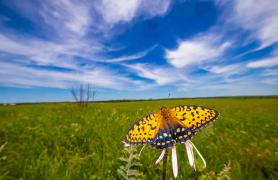Dave Murphy Receives Master Conservationist Award
Former commissioner honored for a lifetime of conservation work
MDC and the Missouri Conservation Commission honored Clark County native and lifelong conservationist Dave Murphy with the Master Conservationist Award on July 20 during a special presentation at the home of MDC Director Sara Parker Pauley.
“Dave Murphy has been and remains a tireless promoter and defender of conservation,” said MDC Director Sara Parker Pauley. “He has spent his long and notable career going to great lengths to support conservation efforts, build conservation partnerships, and help others learn about nature.”
After his college graduation, Murphy spent four years as a wildlife specialist for MDC and was the assistant science coordinator for Columbia Public Schools for four more years. He also worked as a regional director and field supervisor for the National Wild Turkey Federation where he greatly expanded the number of chapters in Missouri.
He also served as a board member for the Missouri Conservation Heritage Foundation and helped start the Missouri Legislative Sportsmen’s Caucus, which supports hunting, fishing, and outdoor recreation.
Murphy also served as the executive director of the Conservation Federation of Missouri from 2003 to 2013, where he initiated and expanded numerous conservation programs in the state, including the Conservation Leadership Corps, Share the Harvest, and the Governor’s Youth Turkey Hunt. Murphy retired from the Conservation Federation in 2013.
In 2014, he accepted a six-year appointment by Missouri Governor Jay Nixon as a conservation commissioner.
Throughout his career Murphy has been recognized by his peers for his contributions to conservation. He has received the E. Sydney Stephens Award from the Wildlife Society, the Citizens Award from the American Fisheries Society, and the Tree Farmer of the Year award from the Society of American Foresters. In 2009, Outdoor Life magazine named him as one of the “25 Most Influential People on the Future of Hunting and Fishing.”
Learn more about the Master Conservationist Award at short.mdc.mo.gov/Zyp.
Jason Sumners Named Deputy Director of Resource Management
Congratulations to Jason Sumners, who was recently named MDC’s new deputy director for resource management. Sumners will assume his new role upon the retirement of current Deputy Director Mike Hubbard on Sept. 23. Sumners is currently the Science Branch chief for MDC where he leads a team of more than 80 scientists who specialize in fish, forest, and wildlife research and management.
Read more from the MDC online Newsroom at short.mdc.mo.gov/4SA.
Turkey Hunters: Submit Fall Feathers
MDC is again asking Missouri turkey hunters to save and submit feathers from birds they harvest this fall for a research project to improve our ability to estimate turkey abundance across Missouri.
Hunters who successfully harvest a turkey during either the archery deer and turkey season or fall firearms turkey season can voluntarily submit feathers from their turkey at no cost. Interested hunters are asked to retain a wing and three to five feathers from the breast after Telechecking their turkey. MDC will mail a feather submission packet, including a postage-paid return envelope to submit feathers at no cost.
To receive a feather submission packet, register at mdc.mo.gov/turkeyfeathers.
Contribute to Bowhunter Observation Survey
MDC encourages bowhunters to help monitor the state’s wildlife populations by reporting sightings through the Bowhunter Observation Survey at short.mdc.mo.gov/4TQ.
Participants record sightings of wildlife — such as coyotes, foxes, deer, wild turkeys, and raccoons — observed while hunting. The survey period starts Sept. 15 and runs through the start of the November portion of firearms deer season.
Past survey participants received paper diaries from MDC to record their sightings. Now, an electronic version is available to make the survey more accessible and the results quickly summarized.
Joel Vance Inducted into Conservation Hall of Fame
MDC posthumously honored Joel Vance, formerly of Russellville, by inducting him into the Missouri Conservation Hall of Fame on June 17 during a ceremony at the Runge Conservation Nature Center in Jefferson City. Vance died on Dec. 9, 2020, at age 86. Vance is the 45th inductee into the Missouri Conservation Hall of Fame. Learn more at short.mdc.mo.gov/ZyG.
Vance was nominated by family members, who accepted the award in his honor.
“Over the decades of his employment with MDC from 1969 to 1991, Vance contributed to the department by being the highly respected and widely heard clarion voice of conservation in the state, giving talks on behalf of the department, conducting seminars and workshops, and helping establish a Public Affairs section for MDC in 1986,” said MDC Director Sara Parker Pauley during the award event. “Most notably, he wrote the Design for Conservation, which established a dedicated sales tax for conservation in 1976.”
Vance also authored many books about conservation topics of all kinds, which showcased his wit, humor, and love of conservation efforts.
Vance was also deeply involved in the conservation movement, serving as president and chairman of the board of directors of the Outdoor Writers Association of America (OWAA) and the Missouri Outdoor Communicators, as well as an active member of the Association for Conservation Information, the Southeastern Outdoor Press Association, and the Association of Great Lakes Outdoor Writers.
Eric Abbott
Conservation Agent for
Andrew, Atchison, Buchanan, Holt, and Nodaway Counties
September ushers in the fall hunting season in Missouri. Amongst the available seasons and methods, one stands out as ideal for introducing youth to the sport of hunting — dove season. The flurry of action in a dove field will capture and keep a youth’s interest. Plus, they will have ample opportunity to use their wingshooting skills. Youth under 15 do not require a permit to dove hunt. Be sure to practice shooting and gun safety prior to hunting. To find ranges or dove management areas near you, visit short.mdc.mo.gov/Z9o. For more information about dove season, consult the Migratory Bird and Waterfowl Hunting Digest 2022–2023 at short.mdc.mo.gov/4SZ.
Gray Bat (Myotis grisescens)

The U.S. Fish and Wildlife Service (USFWS) listed the gray bat as a federally endangered species in 1976. Hibernating populations of gray bats concentrate in caves across Alabama, Arkansas, Kentucky, Missouri, and Tennessee, but in the summer, these bats migrate, extending their range. Gray bats roost in caves, mines, and quarries, but also use structures like bridges, culverts, dams, and storm sewers. At night, they emerge from their roosting habitat to forage on insects, particularly beetles and caddisflies, in addition to flies, moths, and stoneflies.
Why It’s Imperiled
Historical threats include human disturbance to roosting bats, environmental contamination, impoundment of waterways, roost modification or destruction, cave commercialization, improper gating of caves, and natural calamities. Emerging threats include climate change, collisions with wind turbines, and wildlife diseases, like white-nose syndrome (WNS), which has decimated populations of several North American bat species, but fortunately appears not to have impacted gray bat populations.
MDC Restoration Efforts
MDC collaborates with numerous agencies, non-government organizations, and private partners to further the research, understanding, and recovery of gray bats. On MDC lands, we minimize disturbance to cave entrances and the surrounding landscape to promote gray bat use of the habitat. In addition, MDC caves are closed to the public in response to WNS. Range-wide recovery efforts for this species have been successful with population estimates increasing for more than a decade.
What Can You Do?
Avoid disturbing roosting bats. Enter cave environments only under the supervision of experienced individuals, with landowner permissions, and while following proper decontamination and safety procedures.




Red-Eared Slider
Red-eared sliders are one of Missouri’s most common semi-aquatic turtles. Their olive-brown shells cover their body, which is dark green and covered in a pattern of black and yellow lines. Their most distinguishing feature is an elongated, broad red or orange stripe behind each eye. Red-eared sliders spend most of their time basking on logs and rocks. The name “slider” comes from their habit of sliding quickly into the water from these basking spots.
Also In This Issue

Finding space in your yard for native plants.

Tending to the queen of the prairie
And More...
This Issue's Staff
Editor - Angie Daly Morfeld
Associate Editor - Larry Archer
Photography Editor - Cliff White
Staff Writer - Kristie Hilgedick
Staff Writer - Joe Jerek
Staff Writer – Dianne Van Dien
Designer - Shawn Carey
Designer - Marci Porter
Photographer - Noppadol Paothong
Photographer - David Stonner
Circulation Manager - Laura Scheuler






















